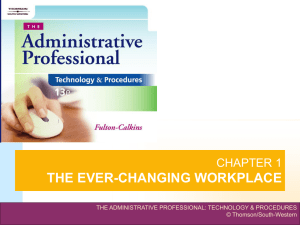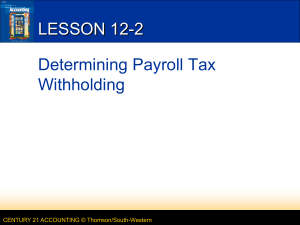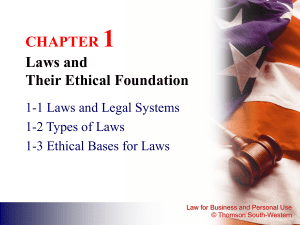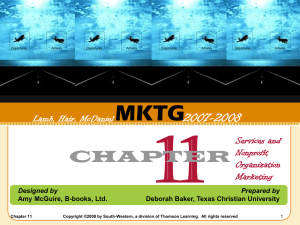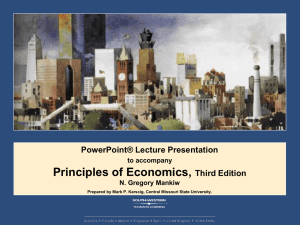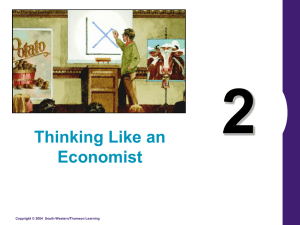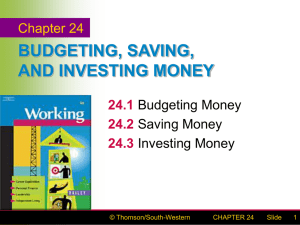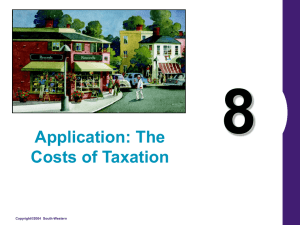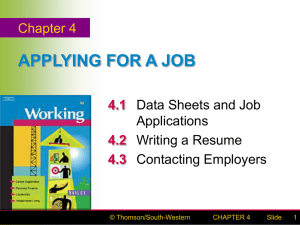Chapter 23 PPT
advertisement
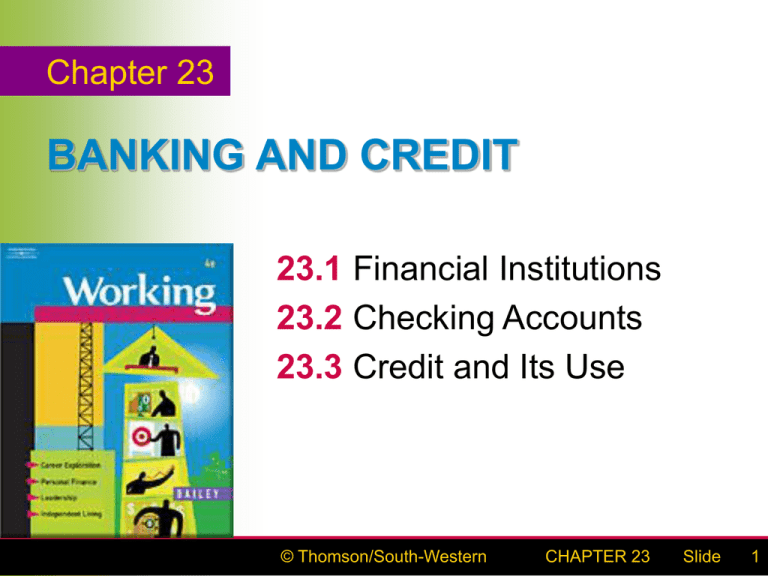
Chapter 23 BANKING AND CREDIT 23.1 Financial Institutions 23.2 Checking Accounts 23.3 Credit and Its Use © Thomson/South-Western CHAPTER 23 Slide 1 Lesson 23.1 FINANCIAL INSTITUTIONS Objectives Name and describe the four major types of financial institutions Discuss how electronic banking may change money management © Thomson/South-Western CHAPTER 23 Slide 2 Lesson 23.1 TYPES OF INSTITUTIONS AND SERVICES Commercial banks Full-service banks offer many financial conveniences and services. Automated teller machines (ATMs) are electronic terminals in which customers can insert a plastic card to withdraw cash, make deposits, or transfer funds to another account. Mutual savings banks Savings and loan associations Credit unions © Thomson/South-Western CHAPTER 23 Slide 3 Lesson 23.1 ELECTRONIC BANKING Electronic banking is a broad term used to describe various types of electronic fund transfers (EFTs). Automated teller machines (ATMs) Telephone banking systems Computer banking systems Direct deposits or withdrawals Point-of-sale transfers © Thomson/South-Western CHAPTER 23 Slide 4 Lesson 23.1 DEBIT CARD A debit card is a plastic card used to immediately transfer funds for a purchase from a bank account to a seller. © Thomson/South-Western CHAPTER 23 Slide 5 Lesson 23.2 CHECKING ACCOUNTS Objectives Describe types of checking accounts and how to open an account Illustrate how to write and endorse a check, maintain a check register, make a deposit, and reconcile a bank statement © Thomson/South-Western CHAPTER 23 Slide 6 Lesson 23.2 UNDERSTANDING CHECKING ACCOUNTS Checks provide a safe and convenient way to pay bills. Checks can be used as freely as cash. Using checks makes it easier to keep good financial records. © Thomson/South-Western CHAPTER 23 Slide 7 Lesson 23.2 TYPES OF CHECKING ACCOUNTS Regular checking account Special checking account Negotiable order of withdrawal (NOW) account Share draft account © Thomson/South-Western CHAPTER 23 Slide 8 SAMPLE CHECK Lesson 23.2 © Thomson/South-Western CHAPTER 23 Slide 9 Lesson 23.2 OPENING A CHECKING ACCOUNT A signature card is a form that is completed when opening a checking account. © Thomson/South-Western CHAPTER 23 Slide 10 Lesson 23.2 WRITING A CHECK Date Postdating is dating a check ahead of time. Payee The person or institution that you write the check to is the payee. Numerical amount Written amount Purpose or account number Signature © Thomson/South-Western CHAPTER 23 Slide 11 A CORRECTLY WRITTEN CHECK © Thomson/South-Western Lesson 23.2 CHAPTER 23 Slide 12 Lesson 23.2 KEEPING A CHECK REGISTER A check register is used to record checks written, deposits made, and other transactions. © Thomson/South-Western CHAPTER 23 Slide 13 SAMPLE CHECK REGISTER Lesson 23.2 ONE-LINE ENTRY TWO-LINE ENTRY © Thomson/South-Western CHAPTER 23 Slide 14 Lesson 23.2 ENDORSING A CHECK An endorsement is your signature, sometimes with a brief message, on the back/left side of a check. Blank endorsement Restrictive endorsement Full endorsement © Thomson/South-Western CHAPTER 23 Slide 15 FORMS OF ENDORSEMENT Lesson 23.2 Blank Endorsement Restrictive Endorsement Full Endorsement © Thomson/South-Western CHAPTER 23 Slide 16 Lesson 23.2 RULES FOR ENDORSING CHECKS AND WITHDRAWING DEPOSITS © Thomson/South-Western CHAPTER 23 Slide 17 Lesson 23.2 MAKING A DEPOSIT The process of putting money into a checking account is known as making a deposit. A deposit ticket is a preprinted form used to make a deposit into a checking account. © Thomson/South-Western CHAPTER 23 Slide 18 SAMPLE DEPOSIT TICKET © Thomson/South-Western Lesson 23.2 CHAPTER 23 Slide 19 Lesson 23.2 STATEMENT OF ACCOUNT A statement of account is a summary of all transactions completed in a checking account for a given time period. The summary includes: Amount of each check and the date the bank received it Deposits you made Any service charges Any interest earned Beginning and ending balances © Thomson/South-Western CHAPTER 23 Slide 20 Lesson 23.2 STATEMENT OF ACCOUNT © Thomson/South-Western CHAPTER 23 Slide 21 Lesson 23.2 BALANCING A CHECKBOOK Comparing the bank statement with your check register is known as balancing (or reconciling) a checkbook. Balancing a checkbook ensures that both you and your bank have recorded all the activity on your account accurately. Instructions on how to balance your account are usually printed on the back of the statement. © Thomson/South-Western CHAPTER 23 Slide 22 Lesson 23.2 FORM FOR BALANCING A CHECKBOOK © Thomson/South-Western CHAPTER 23 Slide 23 Lesson 23.3 CREDIT AND ITS USE Objectives Name and describe the two basic types of credit Calculate the cost of credit © Thomson/South-Western CHAPTER 23 Slide 24 Lesson 23.3 CREDIT Credit refers to the receipt of money, goods, or services in exchange for a promise to pay. © Thomson/South-Western CHAPTER 23 Slide 25 Lesson 23.3 TYPES OF CREDIT Loan credit Sales credit © Thomson/South-Western CHAPTER 23 Slide 26 Lesson 23.3 THE COST OF CREDIT The finance charge is the total dollar amount you pay for using credit. The annual percentage rate (APR) is the percentage cost of credit on a yearly basis. © Thomson/South-Western CHAPTER 23 Slide 27

